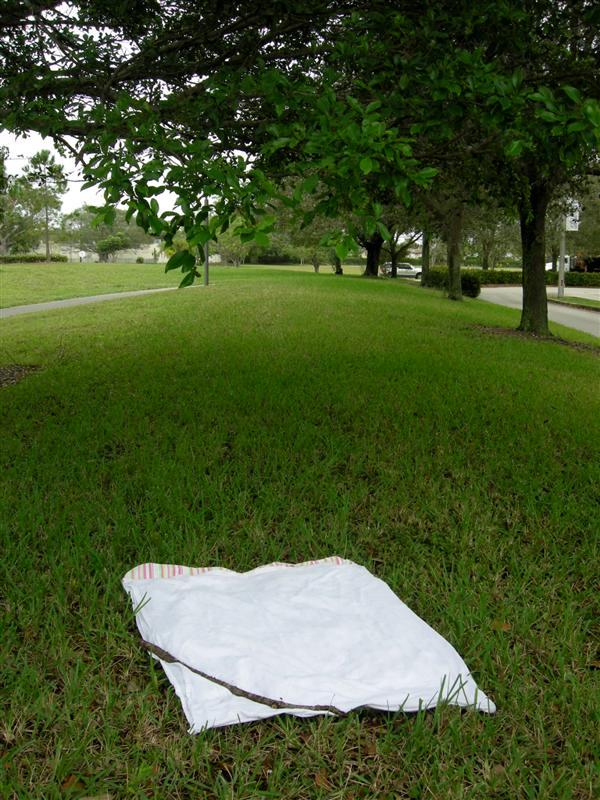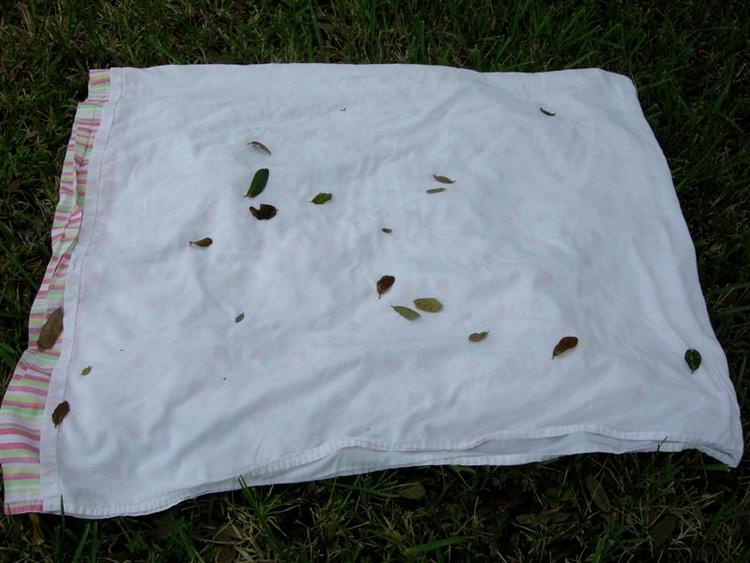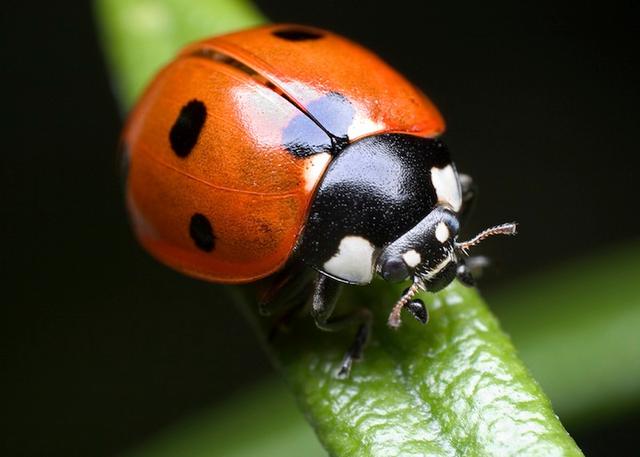| Complexity level: | 7 |
| Project cost ($): | 15 |
| Time required: | You will need time to locate three different species of trees, collect insects from the trees and bring them home for identification using a key. You will need time to settle down the insects for handling. It will also take time to learn to use a key. |
| Safety concerns: | Be careful with biting, stinging or spraying insects! Follow the procedure for handling insects. |
Hypothesis
Overview
Insects are sometimes feared and abhorred as they’re small, fast, creepy and can be destructive and dangerous. They can do great damage to our gardens and houseplants (caterpillars, stink bugs), as well as our homes (termites, ants). They build nests on our houses (wasps) and climb the counters in our kitchens (ants). Sometimes they live in our mattresses (bedbugs), bathrooms (moth flies, silverfish) and basements (earwigs).
In fact, insects are kind of infamous; bug eating contests are held on TV shows. Roach motels are named after cockroaches! Some of us have suffered insect stings or bites from ants and wasps. We may have even accidentally eaten an insect or two (many types of beetle larvae can be found in stored grains and spices if not properly sealed).
Insects can, however, be beneficial to us. In some cultures they are actually eaten for their high protein content. Insects spin the silk we use in clothing (ie. silkworms, aka silkmoth caterpillars). If it weren’t for insects, we wouldn’t have honey (honey bees) and many types of food would be missing from the produce section at the grocery store. Apples, avocados, kale, mangoes, citrus, onions and many more, would all be missing from the shelves without pollinators.
Whether you consider them friend or foe, insects are an important part of our environment. Like all living organisms, insects are classified according to the Linnaean system of biological classification. Insects are classified in kingdom Animalia, phylum Arthropoda and class Insecta. There are approximately 30 different orders of insects.
Insects are sometimes called hexapods because adult insects have 6 legs (“hexa” means 6 and “pod” means foot). There are exceptions to this rule, however. Hence many scientists prefer not to use the term hexapod. Each species is assigned a binomial Latin name, which consists of its genus and species. We humans are known as Homo sapiens, while your dog is Canis lupus familiaris (yes, all dogs are one species). In the insect world, Apis mellifera is a honey bee.
In this science project we are going to classify insects only according to their order. We will take advantage of the fact that insects are cold-blooded. The technical term for cold-bloodedness is poikilothermy, which means that insects vary their temperature according to their environment. In contrast, humans are homeotherms because we are able to maintain a constant temperature (about 98.3?F) using our metabolism. After we have collected our insects, we are going to put the insects in a refrigerator to cool down. Once cooled down, they will be less active and we can observe them more easily.
Dichotomous keys are charts used to identify organisms based on characteristics you can observe with your eyes (even if you need help from a magnifying lens to see them!). “Di” means “two” and for each step in the key, there are two choices to choose from - each one describing a particular trait. To use a dichotomous key start at step one. You will have to choose between two different characteristics, choice "a" or "b". Your choice will either give you the name of the insect order, or tell you to proceed to another step in the key. You won’t necessarily go in sequential order. For example, choice a in step 1 may instruct you to go to step 5, while choice b may refer you to step 8. Continue moving from step to step as the key instructs, until you have identified the insect order.
Scientific Terms
Materials
- White bed sheet
- Stick
- Access to 3 different species of trees with branches that can be reached
- Collecting vials available from a biological supply company (plastic or glass; plastic is lighter weight and less expensive) - at least 15 vials (5 vials per tree)
- Bag to carry vials
- Tweezers
- A sheet of cardboard, approximately 6” x 6” (to place insect on for observation)
- Sewing pins
- Access to a refrigerator or large cooler with ice
- Magnifying lens or dissection microscope (at least 10X)- Plastic and glass hand lenses as well as Sherlock Holmes magnifiers are available in a range of prices from biological supply companies ($2-$40)
Procedure
1) Locate three different species of tree, preferably flowering trees. Most non-flowering trees are evergreens, so choose non-evergreen trees. Although insects do frequent some non-flowering trees, they are more likely to be abundant on flowering trees.
If you don’t know what species the tree belongs to, that’s okay. Just make certain that the three trees are different. You can do this by comparing leaf shape, or the number and arrangement of leaves on each branch. If the tree is flowering, compare flower color, number of petals per flower and arrangement of flowers. If the tree is fruiting, compare the fruit. Botanists also use features of the bark to identify tree species, but that can be tricky.
Hint: You will have better luck finding insects if you look for "feeding damage" on the tree’s leaves. Feeding damage includes skeletonization or holes in the leaves, which indicate the leaves on that tree are tasty to insects. Trees with no feeding damage may not be good host plants.
2) Start with one of your three chosen trees. Choose three branches to beat from this tree. Lay the white sheet directly underneath the first branch and tap with a stick. Make sure you hit the branch itself and not the leaves. If you hit too hard, you may break the branch, and if you hit it too lightly the insects won’t fall off the branch. You can also work your way down the branch towards the tip.

3) As you sample each branch, record the number of insects on each sheet, using table 1 provided. If there are no insects, mark 0 on the table. If there are insects, count the total number of insects on the sheet. If there are too many insects to count, estimate the total number by counting the number of insects in a section and multiplying that by the total number of sections. Record the number in the data table.
The beating sheet is positioned directly under the branch you are going to sample.
4) If there are insects on the sheet after beating, capture them using your collecting vials. If there are too many insects to collect, choose 5 insects at random from the sheet. Don’t collect too many insects. It will take some time to learn how to use the key, so taking only a few insects from each tree is sufficient.
Some insects, like treehoppers, may move so quickly that you won’t be able to collect them. Some insects, like caterpillars, may be easily picked up and transferred to a vial. To collect other insects, you can cover the insect on the sheet with the open end of your collecting vial, reach your hand under the sheet while holding the vial in place, and gently push the insect into the vial. Finally, slide the cap under the vial, keeping it in position so that the insect doesn’t escape.

In the above example, only one weevil was found on the sheet after beating.
5) Repeat steps 2 and 3 with all 3 branches for each of the three trees (A total of 9 branches).
6) Bring the insects back to your station to examine them. This may be your home or a lab. Place the insects in a refrigerator for several hours to "slow" them down. This won’t kill them and you will be able to release them after examining them, if you handle them carefully.
7) After you have cooled down the insects, take them out of the refrigerator one at a time, so that they remain cool for handling. First, try familiarizing yourself with using a magnifying lens for observing parts of the insect. Set the insect on the sheet of cardboard. With one hand, hold the magnifying lens and with your free hand move the insect with tweezers as needed. You may want to place pins around (not in!!) the insect to hold it in place.
8) Once you have figured out how to magnify the insect, turn to the dichotomous keys provided by the American Museum of Natural History
To identify insects, you will use either Key A or B, for arthropods with 6 legs. Please note that larval forms of insects, like flies, beetles and caterpillars, may have more or less than 6 legs. If you find a larval insect, it is most likely from one of those three insect orders.
Key A is for insects with well-developed wings, while Key B is for insects with tiny or missing wings. Some orders appear on both keys. Below is a list of orders from each key. The orders you will most likely find on trees are highlighted in bold text, while the orders you probably won’t find have N/A next to them.
|
|
Quantity of Insects |
||
|
|
Tree 1 |
Tree 2 |
Tree 3 |
|
Branch 1 |
|
|
|
|
Branch 2 |
|
|
|
|
Branch 3 |
|
|
|
|
Total |
|
|
|
Table 1. Total quantity of insects.
|
Insect Orders |
Tree 1 |
Tree 2 |
Tree 3 |
|
Key A |
|||
|
Diptera (larval) |
|
|
|
|
Ephemoptera |
N/A |
|
|
|
Lepidoptera (larval) |
|
|
|
|
Trichoptera |
N/A |
|
|
|
Homoptera |
|
|
|
|
Neuroptera (larval) |
|
|
|
|
Psocoptera |
|
|
|
|
Odonota |
N/A |
|
|
|
Isoptera |
|
|
|
|
Mecoptera |
N/A |
|
|
|
Hymenoptera |
N/A |
|
|
|
Plecoptera |
N/A |
|
|
|
Ephemeroptera |
N/A |
|
|
|
Heteroptera |
|
|
|
|
Coleoptera |
|
|
|
|
Blattaria |
|
|
|
|
Mantodea |
|
|
|
|
Orthoptera |
|
|
|
|
Key B |
|||
|
Phasmida |
|
|
|
|
Collembola |
N/A |
|
|
|
Thysanura |
N/A |
|
|
|
Homoptera |
|
|
|
|
Isoptera |
|
|
|
|
Psocoptera |
|
|
|
|
Thysanoptera |
|
|
|
|
Hymenoptera (Ants & wingless wasps) |
|
|
|
|
Siphonaptera |
N/A |
|
|
|
Dermaptera |
|
|
|
|
Coleoptera |
|
|
|
|
Total # Insect Orders Collected |
|
|
|
Table 2. Insect orders collected by tree


References
Guide to insect orders from Encyclopedia of Life-
http://eol.org/collections/38915
Overview of insect orders on Bugguide-
http://bugguide.net/node/view/222292

